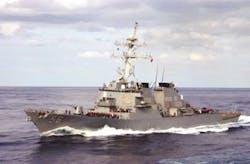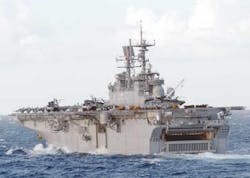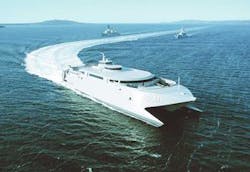Navy Strategy stresses shipboard networking and connectivity
Commercially developed computers, displays, and networks are being developed to link shipboard sensors, weapons, and electronic support systems to give the seagoing service better situational awareness than it has ever had before.
By Edward J. Walsh
U.S. Navy program managers plan to update their surface force for the information age by inserting the latest weapons, sensors, and command and control systems into naval warships.
The new "Sea Power 21" plan, released in a statement late last year, will augment existing plans to field new information-management systems and networks based on commercially developed processing, routing, switching, and systems-management technologies to enable future ship sensors, communication systems, and weapons to support the Navy's long-advertised "network-centric warfare" concept.
Sea Power 21 consists of three pillars:
- sea strike;
- sea shield; and
- sea basing.
These program components address offensive, defensive, and offshore support operations respectively. Linking the pillars will be FORCEnet, planned as an integrated architecture of information networks for combat, command, control, communications, computer, intelligence, surveillance, and reconnaissance (C4ISR) missions. FORCEnet also will provide connectivity to joint-service and national sensor and battle-management systems.
The Navy's Strategic Studies Group, which developed FORCEnet, briefed the chief of naval operations on the concept last summer.
Navy officials insist that Sea Power 21 isn't just another in a series of big-think vision statements. The pillars and FORCEnet, they insist, are building on acquisition programs already in place and technology efforts already funded.
Managers of major programs that are set for fielding in the next decade are giving their programs a transformational Sea Power 21 flavor. An industry team led by Northrop Grumman Ship Systems in Pascagoula, Miss., is continuing system design work on the DD(X) destroyer program, including engineering development models for 11 DD(X) systems. They should complete these models in 2005.
Key engineering development models are:
- integrated electric drive (IED) power and propulsion system;
- advanced gun; and
- integrated suite of multi-function and volume search radars, which will be linked by a total ship computing environment (TSCE).
null
Open-systems architecture
This computing environment is to be an open-systems architecture that will control ship and combat systems, as well as C4ISR systems.
In September 2002 experts from the U.S. Defense Advanced Research Projects Agency (DARPA) in Arlington, Va., released a broad agency announcement seeking industry proposals, due in October of this year, for development of adaptive and reflective middleware systems (ARMS) for the DD(X) program.
The ARMS tools, DARPA officials say, will help the DD(X) team develop distributed real-time and embedded (DRE) combat systems. The ARMS will provide dynamic allocation and migration of DRE applications; standards for commercial-off-the-shelf middleware, a "meta-programmable" DRE framework, and middleware services that guarantee that applications will be independent of specific resource management protocols, security policies, and required fault-tolerant mechanisms.
The new DRS Electric Power Technologies Inc., formed when DRS Technologies acquired the Kaman Aerospace Electromagnetics Center in Hudson, Mass., on Jan. 15, is designing the DD(X) electric-drive architecture. The company combines the former Eaton Naval Controls group — a longtime builder of Navy controls that was acquired by DRS last July — with Kaman, developer of permanent magnet motor technology and already a member of the DD(X).
The new company will build a prototype integrated electric drive motor and the power electronics architecture, including capacitors, power converters, controls, and other components. Power Technology Inc. of Little Rock, Ark., is collaborating with DRS for integration of the large-scale components.
The Navy's Program Executive Office for Surface Strike, which manages the DD(X), also will develop a future cruiser, called CG(X) and a littoral combat ship (LCS), which will operate close to shore against small-boat attacks and hunt mines and hostile submarines.
In early November 2002 the Navy awarded 90-day contracts for studies of LCS concepts to Bath Iron Works in Bath, Maine; Gibbs & Cox in New York; John J. McMullen Associates in Alexandria, Va.; Lockheed Martin Naval Electronics & Surveillance Systems in Syracuse, N.Y.; Northrop Grumman Ship Systems in Pascagoula, Miss.; and Textron Land and Marine Systems in New Orleans.
Cooperative Engagement
The surface navy's cooperative engagement capability (CEC), Navy officials say, will serve as a critical foundation for the time-critical combat-systems networking component of the new vision, especially for linkage with joint systems. CEC, which provides a real-time data picture to shipboard, airborne, and ground-based air defense systems, is set for fielding to Ticonderoga-class cruisers and Arleigh Burke-class destroyers, aircraft carriers, Wasp- and San Antonio-class amphibious assault ships, and E-2C surveillance aircraft.
The current block 1 variant from Raytheon Systems in St. Petersburg, Fla., consists of the USG-2 hardware suite (USG-3 airborne) and version 2.0 software program. CEC went through a successful operational evaluation (OPEVAL) in May 2001 and is aboard about a half-dozen ships.
In early 2002, as a condition for approval of a CEC production decision, Under Secretary of Defense for Acquisition, Technology, and Logistics Edward Aldridge directed the Joint Theater and Missile Defense Office to develop "characteristics and attributes" that the Navy should consider incorporating into a competition for the Block 2 system. The move to seek new capabilities was based largely on support among officials in U.S. Department of Defense (DOD) and some Navy officials for the use of tactical component network (TCN) capability from Solipsys Inc. of Laurel, Md., as a lower-cost alternative to the Navy-proprietary Raytheon CEC.
null
On Dec. 23, 2002, Raytheon and Solipsys announced that Raytheon will acquire Solipsys, opening the door to the insertion of TCN components into the Raytheon CEC.
In a statement, Raytheon said that "Solipsys' expertise in data fusion, data distribution, display, and modeling and simulation will strengthen our product lines and our ability to achieve success in a very competitive marketplace."
For CEC, which already meets the Navy's operational requirement, a CEC processor (CEP) accepts radar tracks data linked from several different ships in a CEC network and creates a common data picture accessible by any of the ships, aircraft, and potentially, ground sites participating in the network. The system uses a high-capacity anti-jam data distribution system (DDS) and an active phased-array antenna to relay the CEC composite track picture among shipboard, airborne, and ground nodes.
Experts from the Johns Hopkins University's Applied Physics Laboratory in Baltimore designed CEC in the early 1980s as a highly secure Navy-unique interface for shipboard combat systems that could support time-critical weapons direction against Cold-War era Soviet targets. As the Cold War threat receded, Raytheon and the Navy pushed to cut CEC weight and costs. The phased-array antenna of the early USG-1 shipboard system included 120 customized transmit-receive modules built by Raytheon's Advanced Device company. The CEP runs C and C++ software code and the DDS initially ran military-unique Ada.
null
In late 2002, Raytheon had delivered 52 of 67 operational evaluation USG-2/USG-3 systems; company officials anticipate contracts for 53 more systems this year. The additional units will run a newer version 2.1 program that incorporates the Navy's ship-self-defense system (SSDS) planned for carriers and big-deck amphibious assault ships. Raytheon's Naval & Integrated Systems business unit in Portsmouth, R.I., is developing the SSDS.
COTS integration
As part of a continuing effort to cut CEC costs, Raytheon in late 2002 completed shock/environmental testing of a new CEC planar array antenna assembly that introduces commercially developed T/R modules and software. In late December 2002, the Navy awarded the company a $5.2 million contract to start production on the planar array antenna.
null
Officials from the Navy, DOD, and industry stress that the networking of target data provided by CEC is the linchpin to future integrated joint-service air defense. Because of cost considerations, the Army and Air Force have not agreed to buy CEC. The Marine Corps, which has approved an operational requirement for CEC, tested the Solipsys TCN extensively and found that it meets Corps needs for sensor netting for situational awareness for dispersed air-defense sites ashore.
Solipsys officials say TCN consists of a series of generic software applications: a data conditioner, current observation-related estimates (CORE), synthesis, segment monitor, visualization or tactical display framework (TDF), messaging, and FACT (fusion algorithm combined track). Unlike CEC, TCN can run on low-cost commercial PCs.
For TCN operations, an element server manages data correlation, association, and tracking for a local sensor. The data conditioner provides an interface for the exchange of sensor information with the element servers; provides needs and accuracy-based data distribution; and accumulates and distributes associated measurements (AMRs) as CORE to local and remote CORE synthesis utilities.
The CORE synthesis fuses CORE data with the network track state into a FACT for use by element servers and data conditioners. The TDF displays the FACT data and the messaging function distributes local CORE data and receives remote CORE and remote data-reporting needs.
Solipsys stresses that the data-management capability of TCN is precise enough to provide users only with data they require, thereby conserving scarce bandwidth, rather than broadcasting large volumes of data throughout the network.
The company has won a series of contracts, awarded through the Naval Air Systems Command at Patuxent River Naval Air Station, Md., to demonstrate TCN in support of battle-group collaborative tracking, carried out by the Seventh Fleet and for ballistic missile defense testing, sponsored by the Missile Defense Agency's sea-based missile defense program at the Pacific Missile Range Facility.
Solipsys officials in 2000 provoked controversy when they formed an alliance with Lockheed Martin's Naval Electronics and Surveillance Systems, longtime prime for the Aegis combat system, to compete with Raytheon for future CEC contracts. The Navy CEC program office also funded a series of tests of TCN.
The characteristics and attributes for Block 2 CEC include communications "extensibility" beyond the Navy-unique DDS through compatibility with other communications systems, such as the Army-Marine Corps enhanced position location reporting system (EPLRS) and the Link 16 joint tactical datalink via the joint tactical information distribution system (JTIDS) and the multi-function information distribution system (MIDS).
System managers say that broader communications compatibility will provide the bigger "pipes" necessary for joint-service connectivity. The Block 2 CEC also will incorporate a requirement for a standard sensor interface and greater bandwidth efficiency — considered a key TCN attribute-as well as upgrades that will reduce size, weight, and cost.
Solipsys officials say that communications extensibility is a critical attribute of TCN. They points out that TCN is portable not only via the CEC DDS, but also via EPLRS, JTIDS, MIDS, the Army-Marine Corps single-channel ground-air radio system (SINCGARS) and other communications systems.
Raytheon experts made several enhancements to CEC, including continuing the insertion of commercially developed algorithms and improving CEC's capability to discriminate among users' needs for sensor data. The company also positioned CEC as a Navy foundation for a joint composite tracking network (JCTN) that could generate a joint-service single integrated air picture (SIAP), the key element of a joint air defense. Raytheon says that CEC, in the JCTN role, potentially could link more than 100 nodes, including air-defense platforms such as Navy ships to track a total of more than 2,400 airborne objects, including theater ballistic missiles. Marine Corps and Army sites also could use it primarily for situational awareness.
Officials in the newly organized Program Executive Office for Integrated Warfare Systems are pursuing a competition for a Block 2 CEC. A formal request for proposals is expected this year and the Navy hopes to award a contract in 2004. Lockheed Martin NE&SS is expected to compete for the award. In December 2002 Lockheed Martin's UK Ltd. business unit won a contract from the U.K. Ministry of Defence for the second phase of a Royal Navy program to integrate CEC aboard the United Kingdom's Type 23 air-defense frigates by 2008.
Aegis upgrades
A critical Navy requirement is CEC interoperability with the Aegis combat system used aboard the Ticonderogas and Burkes, and with the SSDS. Because CEC processes data faster than Link 16, CEC-generated data passed to combat systems may create redundant tracks that degrade weapons targeting — a stubborn problem that persists despite extensive software modifications for CEC and Aegis. Limiting interoperability further is the hierarchical, proprietary Aegis architecture fielded in multiple baselines to 27 cruisers and eventually 62 destroyers.
PEO IWS is continuing discussions with Lockheed Martin on an Aegis open-architecture initiative established in early 2002, PEO managers say that the effort aims at eliminating the mix of autonomous stovepipe-type Aegis software baselines fielded on cruisers and destroyers, all based on dissimilar hardware.
The project also attempts to eliminate the layers of "spaghetti code" that have accumulated within Aegis through progressive software modifications and upgrades, carried out over years to provide new computing capabilities. Aegis engineers say that the system is so tightly integrated that they cannot make changes to specific lines of code without unforeseeable effect on related lines, with the risk of affecting system performance.
PEO officers say that the work builds largely on the planned evolution of the Aegis combat system to a commercial computing architecture based on introduction of the Lockheed Martin AN/UYQ-70 processor.
The 'Q-70 comes from an industry team led by Lockheed Martin's Tactical Defense Systems in Eagan, Minn., which also built the UYK-43 and UYK-44 Navy proprietary computers for nearly all shipboard processing and display functions. Themis Computer of Fremont, Calif., supplies the mission-critical applications of Q-70 with products based on UltraSPARC microprocessor from Sun Microsystems in San Jose, Calif. Sun supplies directly for relatively benign applications not involved in combat command and control.
The Navy started moving towards Aegis open architecture by introducing a commercially developed tactical graphics capability with baseline 5 phase 3 aboard Burke-class destroyers beginning with the USS Mitscher (DDG-57). Baseline 6 phase 1 for DDGs-79 through -84 introduces four "adjunct" processors, based on UYQ-70 technology, that provides a bridge to the UYK-43 computers that control the Aegis display system. Baseline 6 phase 3 (DDGs-85 through -90), adds adjunct processors for the SPY-1D Aegis phased-array radar and the Aegis weapon system, as well as new processor boards called symmetric processors that emulate several functions of the UYK-43. Baseline 7 phase 1, aimed at DDG-91 through -107, finally replaces the UYK-43 with commercial off-the-shelf (COTS) processors fitted in a hardened housing.
Aegis software
Lockheed Martin, funded through continuing Aegis technical support contracts, is conducting analyses and experiments to map out software approaches for the open architecture, now targeted for baseline 7 phase 2. The HIPER-D (high-performance distributed computing) test bed run together by the Navy and DARPA at the Naval Surface Warfare Center's Dahlgren division in Dahlgren, Va., also is supporting Aegis open architecture development.
Company officials say that the open-architecture work will extend the system's ability to introduce new warfighting capabilities and reduce development time and maintenance costs. They say they also expect to help manage the obsolescence of COTS components and improve usability through a more effective human-system interface.
Lockheed Martin experts say the open architecture effort uses object-oriented software methodologies and design patterns to provide a "flexible, component-based software architecture and a scalable 'bedrock' for future combat system functionality and performance improvements." Open-architecture code development uses unified modeling language (UML) case diagrams and specifications, activity diagrams, information or "domain-object" models, locality diagrams, and middleware that will segregate applications code from required processor hardware upgrades.
The hardware foundation for Aegis upgrade, the UYQ-70, continues to evolve to support the open architecture. In September 2002 Lockheed Martin delivered to the Space and Naval Warfare Systems Command (SPAWAR) the first web-enabled 'Q-70 server. Company officials say the web-server will host the web-enabled naval tactical command support system (eNTCSS) application software for maintenance, logistics, and other tasks via a standard web browser through any workstation on the ship's local area network.
The system originally was built with the Hewlett Packard HP744 processor in a VME-based architecture, using PCI on mezzanine card (PMC) technology for high-rate data offload onto a secondary bus, running the HP-UX Unix operating system, which provided X-Windows and Motif graphic user interfaces.
'Q-70 evolution
The 'Q-70 initially was for non-real time processing and display functions. It has been extended to real-time operations, employing an HP-RT software kernel. The Aegis community has been the biggest 'Q-70 customer. For Aegis cruiser baseline 7 phase 1, 'Q-70 variants will run the entire combat system-radar, command & decision, and weapons control, and the undersea weapon system.
The 'Q-70 system is adapting to a range of additional processors and operating systems, beginning with Sun's Solaris. The Navy's detection, navigation, and processing systems office also has introduced 'Q-70s with a processor from Themis Computer.
SPAWAR started incorporating 'Q-70s into the Navy's information technology (IT-21) processor architecture last year. In a demonstration aboard the sea-based battle lab aboard the command ship USS Coronado, SPAWAR also has looked at a "mission-essential" 'Q-70 variant that handle non-real-time command and control data over a network of ultra-thin client workstations.
New ship networks made possible by the 'Q-70 and open architecture technologies will support the Sea Power 21 pillars. The Navy is still identifying the technologies and systems necessary to implement the three operational pillars and the FORCEnet concept.
FORCEnet, Navy managers say, extends the concept of the JTF WARNET, a hardware and software architecture that will integrate joint-service communications systems for long-range command and control in coastal waters. It also will incorporate knowledge-web technologies, a suite of web-management software tools that support Navy and joint-forces collaboration, and new antenna aperture technology, being developed as the advanced multi-function radio frequency concept (AMRF-C).
The Office of Naval Research (ONR) sponsored the development of knowledge web technologies in collaboration with the Third Fleet, Atlantic and Pacific Fleet groups, Fleet Forces Command, the Navy's Network Center Innovation Center, and SPAWAR Systems Command.




